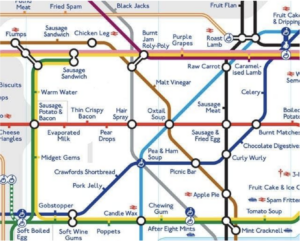
As I’m thinking about the limits of visuals to render taste (a major theme of the project), here is a quick screen taste test. Perhaps it’s an example that disrupts the assumption that a visual can transmit taste accurately.
How do you absorb the visual above?
How does your relationship to it change when you read the description below?
“First, there’s a layer of ladyfingers, then a layer of jam, then custard, which I made from scratch, then raspberries, more ladyfingers, then beef sauteed with peas and onions, more custard, and then bananas, and then I just put some whipped cream on top!” (It’s the delicious trifle from the the TV show “Friends” )
Did the simple descriptive language get something across that the image couldn’t? Did it untangle the simultaneity of the image with (a small) dramatic and tasty effect?
OTHER TASTY PLACES
While further contemplating how we encounter the sense of taste in digital environments, I am searching for/thinking about on-screen examples that produce an experience of taste for me — or at least productive associations between visuals and taste & smell.
Perhaps I am looking for ways to create unlikely synesthesia (= an automatic overlapping/joining of senses). Below is James Wannerton’s London tube map. He is a synesthete who intuitively associates geography/places with taste. I think the language on the map is sparse but descriptive (as opposed to evaluative which could be a scale of bad-tasting to good-tasting, e.g. ) and therefore more evocative.

LESS OUT THERE, MORE PRACTICAL
This week, at the very beginning of Overbaked&Underproofed I’ve mostly been thinking about how the proposal’s ideas, timelines, role-concepts map onto the reality of the semester. Now that we have a splendid team of three (Teddy, RC, me) and a concrete timeline, my lens on the project is shifting. Something I’d call “practicality mode” is kicking in. A mode that’s very different from the grant-focused mode. I prefer practicality mode.
As a group we still have to make some decisions about workflow & communication structure, but we’ve already collected possibilities. So far we have a shared google drive to collect relevant project info, and we have a doc that collects weekly questions. The questions encompass practical as well as conceptual issues. This week they’re everything from “Shall we use Trello?” to “What’s a good way to house and begin tagging this GBBS corpus?”
Wrangling the corpus will be the main focus of our first month, and it is an immensely exciting part of the endeavor. I think much of the project’s ultimate shape will be defined by what we get from the corpus. Teddy (!!!) found a published transcript of GBBS that will save us a ton of work and frees us up to think about additional ways of annotating the corpus. What else, other than evaluative judging language, might we want to track? Usage related to speaker? Shifts related to episode theme? How contestants of different language backgrounds absorb and reuse the GBBS language?…


